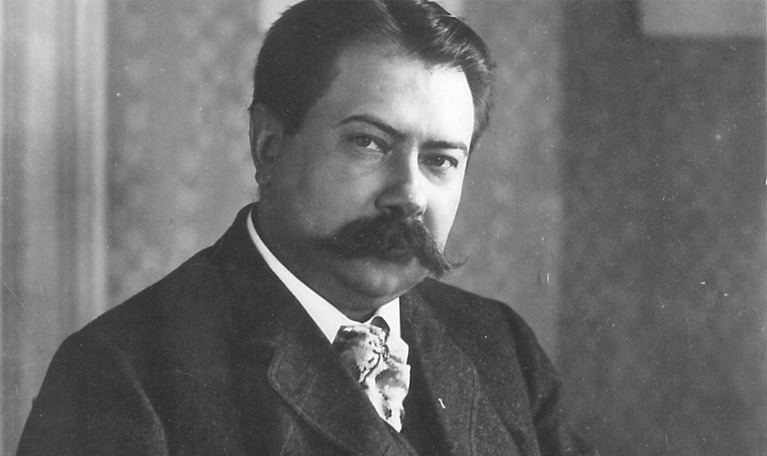Birth of the Orchestra

Tor Aulin, key-figure when the orchestra was founded.
Conductor, violinist, composer – and founder of the Stockholm Concert Society. The orchestra’s history begins with Tor Aulin, who participated in a total of 83 concerts with the orchestra.
A new epoch in the Stockholm music scene
On Tuesday, 21 October 1902, the Royal Swedish Academy of Music’s main hall was packed with an expectant audience, spearheaded by King Oscar II. The newly formed Stockholm Concert Society performed its first concert. An orchestra of some seventy musicians was on stage; the conductor was Tor Aulin, best known at that time as a violinist and composer, and fellow composer and pianist Wilhelm Stenhammar took part as a soloist.
Ten days earlier in Dagens Nyheter, Wilhelm Peterson-Berger raised expectations by writing:
“This company (Stockholm Concert Society) has been started in what is, for Stockholm, an unfamiliar and grandly genuine style” and serves as “powerful evidence of a flourishing musical culture in Stockholm.” He concludes his article: “We can be proud: never before has Stockholm encountered such a splendid musical season.”
The concert programme included Beethoven’s Symphony No. 4; César Franck’s Symphonic Variations for Piano and Orchestra; Peter Cornelius’ overture to the Barber of Baghdad and, to conclude, Berwald’s Sinfonie sérieuse. The programme was fascinating, seamless – and well received. The next day, P.B. began his review with the words: “It was a victory, a huge victory” and the signature “N” in Svenska Dagbladet denotes that Stockholm’s music scene had suddenly become continental, that the concert marked “the beginning of something strong and viable, forming an epoch in our concert history.”
The story of Stockholm Concert Society begins in December 1901, when Aulin, Stenhammar and director John May met up to, as a handwritten paper in the Stockholm Konserthuset Foundation’s archives explains, “discuss Aulin’s proposal to form an orchestra for the 1902/03 season, which would perform symphonic concerts in Stockholm and certain cities in the country, such as Gothenburg, Uppsala, Gävle, Sundsvall, Norrköping, Örebro and other cities.”
To understand this initiative, one must be aware that at this time, Sweden had only one professional orchestra, the Royal Court Orchestra, which gave symphonic performances in addition to its opera services. In the nineteenth century, a growing body of orchestral music had also been composed – from Beethoven to Mahler. Thus, a need arose for orchestras that could present this music.
Tor Aulin had already started working on certain orchestral operations within the framework of Svenska Musikerföreningen (the Swedish Music Association) a few years earlier. Now as he pursued the creation of Stockholm Concert Society, he knew that both musical resources and public interest existed.
On 1 April 1902, an announcement was sent out about the formation of the “Orkester-Konsert Förening” (“Orchestra Concert Association”) in Stockholm. The announcement declared the intention to engage the city’s resident musicians for ten concerts in Stockholm during the period of October-April. Four of these concerts would be popular concerts “intended primarily for workers.” It is important to note the fact that from the very beginning, the Stockholm Concert Society considered it an important goal to spread orchestral music to new groups of listeners.
On 14 May, a meeting was held to review the subscriber figures. Nearly SEK 10,000 had been collected for the operation’s first season, leading to a constituent meeting on 27 May at which the Stockholm Concert Society was declared to be formed, by-laws were adopted and a board of directors was selected. John May was chairperson, Stenhammar vice chairperson, Tor Aulin conductor, Ernst Högman secretary and Ludvig Rubenson junior treasurer. Rubenson had worked enthusiastically to gather financial contributions before the inception.
At the board meeting on 22 August, he announced subscription commitments amounting to SEK 21,000 for the upcoming season. Negotiations would be held with the Royal Swedish Opera and the Royal Swedish Academy of Music to hire a performance hall and to discuss approved proposals for the subscriber list.
Accordingly, from the very beginning, the Stockholm Concert Society/Philharmonic’s concert operations have been based on a subscription system. Aulin was tasked with negotiating with soloists for the concerts. The board wanted to focus primarily on Nordic musicians.
In late September, the public was invited to sign up for subscriptions for six symphonic concerts for the 1902/03 season. “Subscription booklet, containing tickets for the complete series (six concerts) with entitlement to the seat of your choice, available from the music retailer at a cost of 12 kronor.”
Rather than having a fixed ensemble, for each individual concert, the orchestra was composed of members of the Royal Court Orchestra and the Swedish Music Association. After the successful debut concert, performances were given on 6 December, 16 December, 27 January, 7 and 21 March and 9 April.
Already in the first season, a series of characteristic traits emerged in Aulin’s programming. Almost every concert included newer Swedish music, which became even clearer in subsequent seasons.
Examples of premiere performances conducted by Tor Aulin in the first years of operation include: Wilhelm Stenhammar, Symphony No. 1 in F Major (16 December 1903); Wilhelm Peterson-Berger, Symphony No. 1 in B Flat Major “Baneret” (23 February 1904); and Franz Berwald, Sinfonie singulière in C Major (10 January 1905).
Aulin enjoyed introducing unplayed pieces by the romantic composers. Vocal soloists were popular and regularly appeared on programmes, often together with an instrumental soloist. Aulin was particularly keen on the music of Wagner and enjoyed concluding concerts with excerpts from Wagner’s operas.
The programme layout may seem backwards to a contemporary audience. They began with heavier works and played lighter pieces after the intermission, often concluding with an overture.
Among the pieces performed during the first season are Bruckner’s Symphony No. 4; Mendelssohn-Bartholdy’s Violin Concerto; Beethoven’s Symphony No. 7; Schubert’s Great Symphony in C Major; Ludvig Norman’s Symphony No. 3 and Beethoven’s Piano Concerto No 5.
In addition to the subscription concerts, four community concerts were performed with popular programmes and low ticket prices, introduced by the board’s secretary Ernst Högman – the association’s first master of ceremonies. Of these concerts, the magazine Hvar 8 Dag wrote on 11 January 1903: “The second community concert was recently held and it can be said with no exaggeration that more magnificent community concerts are not performed anywhere else in the world.” The first tour concerts were also arranged, including one in Uppsala in 1903.
Stockholm Concert Society flourished from the very beginning, and in its second year, it continued with the same ambitions that permeated the first – six subscription concerts and four community concerts. At that point, they also received funding from the City of Stockholm for the community concerts. However, that would be the only municipal funding the association would receive until a dedicated, fixed orchestra was established in 1914. The state did not allocate any funds.
Support for the community concerts also turned out to be short-term. It was deemed to be insufficient early on. When the association did not receive increased funding as requested in 1908, the community concerts were put to rest and never reinstated.
The subscription concerts included many fascinating elements. On 10 January 1905, Aulin premiered Berwald’s Sinfonie singulière from the manuscript (60 years after the symphony was composed). Since the 1890s, Beethoven had been a favourite of the Stockholm music scene; other frequently played composers included Grieg and Mozart. Berlioz’s symphony Harold in Italy was presented in 1906, as was Liszt’s Faust Symphony. Sibelius’ recently composed Symphony No. 2 was presented in 1903 – and Tor Aulin conducted essentially all of the concerts.
Gradually, the operation began to develop problems. The cost of hiring the Swedish Academy of Music’s main hall was considered too high, and the hall was also considered unsuitable for orchestral concerts for other reasons. But no one could track down a better alternative, so performances continued to be given in this hall until spring 1910. Finances deteriorated, and emigrant to Sweden and violinist Henri Marteau donated the proceeds of one concert (SEK 800) to the Stockholm Concert Society in April 1909, but it did not help significantly.
At the same time, Tor Aulin also announced his employment as conductor of the Gothenburg Orchestra Association, founded in 1905, where Stenhammar had been artistic director since 1907. Stockholm’s orchestra was dissolved and in the 1909/10 season, the Stockholm Concert Society’s operations consisted of four guest performances by the Gothenburg Symphony Orchestra!
On 1 June 1910, the Stockholm Concert Society’s working committee (to which Aulin belonged) realised that no orchestral concerts could be arranged for the 1910/11 season. Only five chamber music concerts were arranged that year. From autumn 1911 through December 1913, the association held no concerts at all. But the operation was kept alive and annual meetings were held in both 1910 and 1912. The Berwald Foundation, formed in 1909 by the Stockholm Concert Society, was active for the composer’s music, and with the help of Henri Marteau, Stockholm Concert Society arranged a Swedish music festival in Dortmund in June 1912.
But then, something happened in autumn 1913. One of the major concerns during those early years had been that the main hall at the Swedish Academy of Music was too small to produce sufficient income from ticket sales. Now the board had found a solution to the location issue – a huge space in Norra Bantorget with room for over 1,600 people, called Auditorium. This resulted in the Stockholm Concert Society restarting orchestral operations. But their aim was higher now than before and they wanted to create a fixed, employed symphony orchestra that would perform several concerts per week during the October–April season.
Financing was primarily arranged through private means via donations and a system of paying donors and permanent members. Auditions were held for the entire orchestra in November and December, and on 2 January, the approximately 60 members of the new orchestra met for rehearsal under the baton of conductor Hans Seeber van der Floe.
The first concert was performed on 15 January 1914, with music by Beethoven and Wagner. Thus began the development that would lead to today’s performances by the Royal Stockholm Philharmonic Orchestra at Stockholm Konserthuset in earnest.
By Bengt Olof Engström
Executive director of Konserthuset 1976–86
This article was published in the anniversary publication 100 års musik – Från Konsertföreningen till Kungliga Filharmonikerna 1902–2002 (100 Years of Music – From Stockholm Concert Society to the Royal Stockholm Philharmonic Orchestra 1902–2002)
